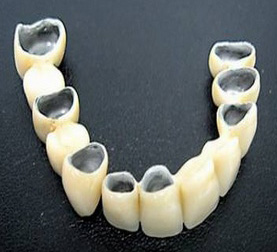Metal-ceramic crowns and bridges

As the name implies, metal-ceramic crowns are composed of two layers: an inner metal layer that accurately fits the polished tooth stub and provides strength, and a ceramic layer that defines the aesthetic appearance of the crown. They are suitable for both anterior and posterior teeth.
The biggest advantage of metal-ceramic crowns is their strength and resistance to occlusal forces.
Disadvantages of metal-ceramic crowns and bridges The metal layer blocks the passage of light. Such crowns and bridges can be (especially in the tooth neck area) gray, dark and unnatural. It is impossible to make a dental crown naturally thin and the tooth edge is usually not sharp. If you want to have a metal-ceramic crown as natural as possible in shape and color, a dentist must remove more of the tooth enamel so that there is enough space for the ceramic layer overlap the metal structure. In sensitive patients, metal alloy that forms a backbone of ceramic dental restorations can produce metallic aftertaste in the mouth, irritation or allergic reactions. After removing the metal elements of the crowns these problems usually recede.

